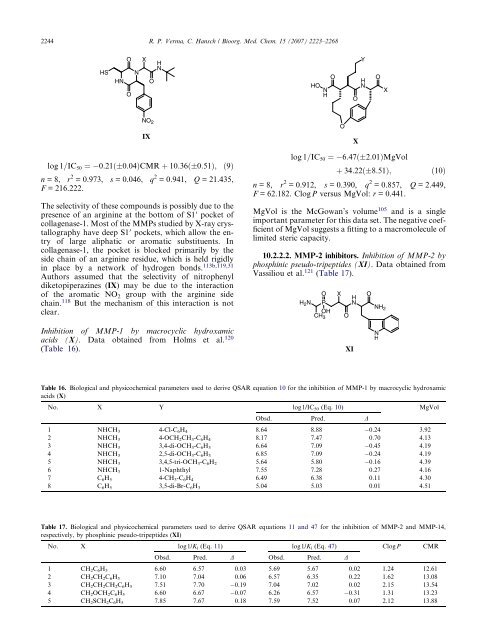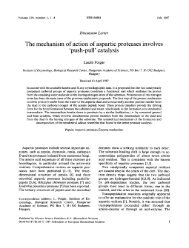Matrix metalloproteinases (MMPs): Chemical–biological functions ...
Matrix metalloproteinases (MMPs): Chemical–biological functions ...
Matrix metalloproteinases (MMPs): Chemical–biological functions ...
You also want an ePaper? Increase the reach of your titles
YUMPU automatically turns print PDFs into web optimized ePapers that Google loves.
2244 R. P. Verma, C. Hansch / Bioorg. Med. Chem. 15 (2007) 2223–2268<br />
HS<br />
HN<br />
O<br />
O<br />
N<br />
X<br />
O<br />
NO 2<br />
log 1=IC50 ¼ 0:21ð 0:04ÞCMR þ 10:36ð 0:51Þ; ð9Þ<br />
n =8, r 2 = 0.973, s = 0.046, q 2 = 0.941, Q = 21.435,<br />
F = 216.222.<br />
The selectivity of these compounds is possibly due to the<br />
presence of an arginine at the bottom of S1 0 pocket of<br />
collagenase-1. Most of the <strong>MMPs</strong> studied by X-ray crystallography<br />
have deep S1 0 pockets, which allow the entry<br />
of large aliphatic or aromatic substituents. In<br />
collagenase-1, the pocket is blocked primarily by the<br />
side chain of an arginine residue, which is held rigidly<br />
in place by a network of hydrogen bonds. 113b,119,31<br />
Authors assumed that the selectivity of nitrophenyl<br />
diketopiperazines (IX) may be due to the interaction<br />
of the aromatic NO2 group with the arginine side<br />
chain. 118 But the mechanism of this interaction is not<br />
clear.<br />
Inhibition of MMP-1 by macrocyclic hydroxamic<br />
acids (X). Data obtained from Holms et al. 120<br />
(Table 16).<br />
IX<br />
H<br />
N<br />
HO NH<br />
O<br />
O<br />
log 1=IC50 ¼ 6:47ð 2:01ÞMgVol<br />
þ 34:22ð 8:51Þ; ð10Þ<br />
n =8, r 2 = 0.912, s = 0.390, q 2 = 0.857, Q = 2.449,<br />
F = 62.182. ClogP versus MgVol: r = 0.441.<br />
MgVol is the McGowan’s volume 105 and is a single<br />
important parameter for this data set. The negative coefficient<br />
of MgVol suggests a fitting to a macromolecule of<br />
limited steric capacity.<br />
10.2.2.2. MMP-2 inhibitors. Inhibition of MMP-2 by<br />
phosphinic pseudo-tripeptides (XI). Data obtained from<br />
Vassiliou et al. 121 (Table 17).<br />
O X<br />
H2N P<br />
OH<br />
CH3 O<br />
Table 16. Biological and physicochemical parameters used to derive QSAR equation 10 for the inhibition of MMP-1 by macrocyclic hydroxamic<br />
acids (X)<br />
No. X Y log1/IC50 (Eq. 10) MgVol<br />
Obsd. Pred. D<br />
1 NHCH3 4-Cl-C6H4 8.64 8.88 0.24 3.92<br />
2 NHCH3 4-OCH2CH3-C6H4 8.17 7.47 0.70 4.13<br />
3 NHCH3 3,4-di-OCH3-C6H3 6.64 7.09 0.45 4.19<br />
4 NHCH3 2,5-di-OCH3-C6H3 6.85 7.09 0.24 4.19<br />
5 NHCH3 3,4,5-tri-OCH3-C6H2 5.64 5.80 0.16 4.39<br />
6 NHCH3 1-Naphthyl 7.55 7.28 0.27 4.16<br />
7 C6H5 4-CH3-C6H4 6.49 6.38 0.11 4.30<br />
8 C6H5 3,5-di-Br-C6H3 5.04 5.03 0.01 4.51<br />
Table 17. Biological and physicochemical parameters used to derive QSAR equations 11 and 47 for the inhibition of MMP-2 and MMP-14,<br />
respectively, by phosphinic pseudo-tripeptides (XI)<br />
No. X log1/Ki (Eq. 11) log1/Ki (Eq. 47) ClogP CMR<br />
Obsd. Pred. D Obsd. Pred. D<br />
1 CH2C6H56.60 6.57 0.03 5.69 5.67 0.02 1.24 12.61<br />
2 CH2CH2C6H5 7.10 7.04 0.06 6.57 6.35 0.22 1.62 13.08<br />
3 CH2CH2CH2C6H5 7.51 7.70 0.19 7.04 7.02 0.02 2.15 13.54<br />
4 CH2OCH2C6H5 6.60 6.67 0.07 6.26 6.57 0.31 1.31 13.23<br />
5 CH2SCH2C6H5 7.85 7.67 0.18 7.59 7.52 0.07 2.12 13.88<br />
XI<br />
O<br />
X<br />
H<br />
N<br />
Y<br />
H<br />
N<br />
O<br />
O<br />
X<br />
NH 2<br />
N<br />
H



